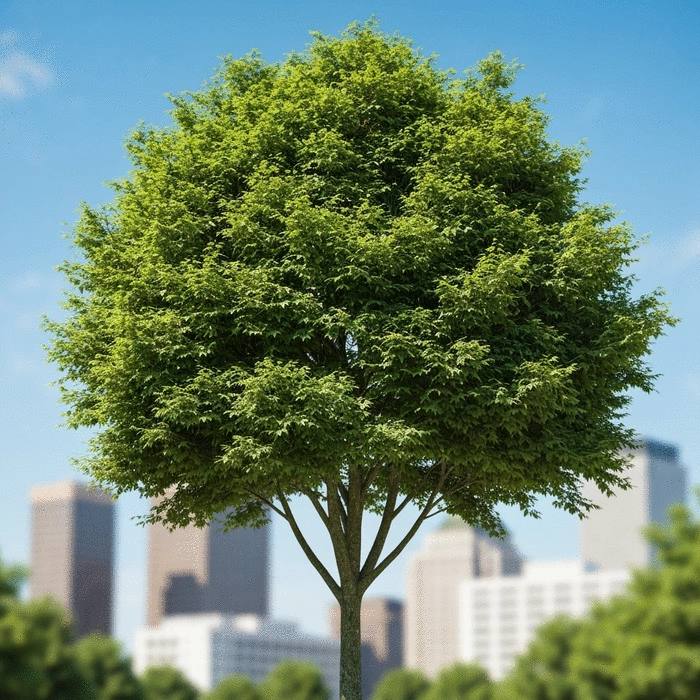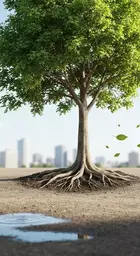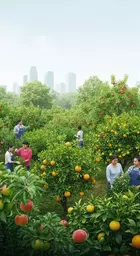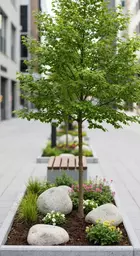Urban Trees: Low-Maintenance Options

Posted on: 2025-07-22
By: Keira Vallejo
Ever walked through a park and felt instantly rejuvenated by the greenery around you? Trees are much more than just stunning landscapes; they are the backbone of our urban environments, providing essential benefits to both nature and society. Understanding the significance of tree selection can transform our cities into thriving ecosystems.
What You Will Learn
- Trees greatly enhance urban air quality by absorbing pollutants and producing oxygen.
- Urban trees provide essential cooling effects, reducing heat and creating comfortable outdoor spaces.
- Choosing low-maintenance and resilient tree species helps ensure long-term sustainability and lower upkeep costs.
- Properties near green spaces enjoy increased real estate values, making tree planting an economic boon.
- Diverse tree species support local wildlife and enhance urban biodiversity, promoting healthier ecosystems.
- Community engagement in tree planting fosters social interactions and strengthens neighborhood ties.
- Being involved in local urban greening initiatives can lead to significant improvements in community spaces and environmental health.
Key Benefits of Urban Trees
The following visual highlights the essential environmental and social benefits of urban trees, comparing the impacts they have across various aspects of urban life.
Improved Air Quality
Absorb pollutants & produce oxygen.
Urban Cooling
Provide shade & reduce heat.
Stress Reduction
Lower stress levels with greenery.
Enhanced Property Values
Higher real estate values near trees.
Social Cohesion
Encourage community gatherings.
Health Benefits
Lower healthcare costs with green access.
Understanding Urban Tree Selection: Key Considerations
When we talk about trees in our cities, it’s crucial to understand how to select the right ones. Trees contribute so much to our urban landscapes, from providing shade to enhancing air quality. At Urban Canopy Blog, I believe that making informed decisions about tree selection can significantly impact our communities and environments!
Choosing the right tree species is not just about aesthetics; it’s about the long-term health and resilience of our urban ecosystems. As we delve into the key considerations for selecting trees, we'll explore the environmental benefits, social value, and the characteristics that make trees thrive in urban spaces.
Importance of Trees in Urban Environments
Trees play a vital role in shaping urban areas. They help reduce heat, improve air quality, and even boost our mental health! Just imagine walking through a park filled with lush greenery—it's not just beautiful; it's essential for our well-being.
Moreover, trees can significantly impact the economy. They increase property values and attract tourism, turning our cities into vibrant, livable spaces. So, when we consider planting trees, we’re not just enhancing our environment; we’re also investing in our community's future!
- Improved Air Quality: Trees absorb harmful pollutants and produce oxygen.
- Urban Cooling: They offer shade and reduce heat in city areas.
- Stress Reduction: Being around greenery can lower stress levels.
Environmental Benefits of Urban Trees
Let’s dig a little deeper into the environmental impact. Urban trees help combat climate change by absorbing carbon dioxide. They also improve water quality by reducing runoff and preventing soil erosion. Isn’t it amazing how these green giants can tackle so many issues?
Additionally, trees provide habitat for wildlife, making our cities more biodiverse. By planting diverse species, we’re not only beautifying our neighborhoods but also supporting the local ecosystem. A tree is more than just wood and leaves; it’s a vital part of our urban web!
Social and Economic Value of Green Spaces
The social benefits of urban trees are equally impressive. Green spaces foster community interactions, encouraging people to gather and enjoy nature together. Remember that feeling of relaxation you get when you sit under a tree on a sunny day? That’s a shared experience that can strengthen community ties.
On the economic side, studies show that properties near green spaces have higher real estate values. People are willing to pay more for homes with nearby parks or tree-lined streets. It’s a win-win situation for both residents and local governments!
- Enhanced Property Values: Proximity to trees can increase home prices.
- Social Cohesion: Parks and green areas encourage community gatherings.
- Health Benefits: Access to green spaces can lead to lower healthcare costs.
Characteristics of Low-Maintenance and Resilient Tree Species
Now that we've established the importance of trees, let's look at the characteristics of low-maintenance and resilient tree species. For those of us living in urban areas, it’s essential to choose trees that will thrive with minimal care yet still provide maximum benefits.
Low-maintenance trees are ideal for busy city dwellers. They require less pruning, watering, and pest management, allowing us to enjoy their beauty without a heavy commitment. At Urban Canopy Blog, I strive to share insights about trees that can flourish in our urban settings, making it easier for everyone to get involved in tree care!
- Less Prone to Disease: These trees typically have strong resistance to pests.
- Adaptable to Urban Conditions: They can thrive in various soil types and climates.
- Low Water Needs: They require less irrigation, saving water resources.
Quick Summary
Here's a brief recap of the key points discussed so far:
- Urban trees provide essential benefits such as improved air quality, urban cooling, and stress reduction.
- Choosing the right low-maintenance and resilient tree species is crucial for enhancing urban environments.
- Community engagement and sustainable practices can significantly impact the success of urban greening initiatives.
Summarizing the Importance of Urban Trees
As we wrap up our discussion on urban trees, it's clear that selecting the right species is essential for thriving city landscapes. Low-maintenance and resilient tree species play a crucial role in urban environments, providing benefits that extend beyond mere aesthetics. Choosing trees that require less upkeep helps city dwellers enjoy more greenery without overwhelming responsibilities!
To recap, the characteristics of these trees—such as their pollution tolerance, drought resistance, and adaptability to compacted soils—make them ideal choices for our bustling cities. Trees like the Eastern Redbud and Black Tupelo not only beautify our streets but also contribute significantly to the environment and our well-being.
Recap of Low-Maintenance and Resilient Tree Species
Low-maintenance trees are perfect for busy urban settings. They require less water, are disease-resistant, and can thrive in poor soil conditions. Here are some tree species that fit this description:
- Eastern Redbud - known for its stunning spring blossoms.
- Black Tupelo - offers vibrant fall color and wildlife habitat.
- London Planetree - resilient and adaptable to urban challenges.
- Kentucky Coffeetree - a unique species that thrives in various conditions.
These trees are not just about low maintenance; they are also resilient against urban stresses, making them a smart choice for city planners and residents alike!
Reiterating the Environmental and Social Benefits
Urban trees do an incredible job of enhancing both our environment and quality of life. They improve air quality, provide shade, and even help reduce urban heat. The presence of trees can lead to lower energy costs and increased property values, making it a win-win for everyone!
Moreover, the social benefits of urban trees cannot be overlooked. They create inviting spaces where community members can connect and engage. Studies show that neighborhoods with more trees often report higher levels of community involvement and lower crime rates. Imagine taking a stroll through a tree-lined park, feeling the calming effects of nature surrounding you!
Encouraging Sustainable Urban Landscaping Practices
So, what can you do to promote sustainable urban landscaping in your community? It all starts with planting the right trees! Engaging with your neighbors about the importance of trees can spark interest in urban greening initiatives and lead to a healthier environment.
When considering tree planting, remember to select species that are suitable for your local climate and soil conditions. This ensures that your efforts are sustainable and beneficial in the long run. Plus, planting trees fosters a sense of community pride and responsibility!
Taking Action: Planting the Right Trees in Your Community
Ready to make a change? Here are some steps you can take to encourage tree planting in your area:
- Choose native species that thrive in your local environment.
- Organize community tree-planting events.
- Educate others on the benefits of urban greenery.
- Partner with local organizations focused on urban forestry.
By taking these steps, you're not just planting trees; you're also nurturing a community that values sustainability and environmental stewardship!
Engaging with Local Initiatives for Urban Greening
To truly maximize your impact, get involved with local initiatives aimed at enhancing urban greenery. Many cities have programs dedicated to tree planting and urban forestry, and participation can lead to significant improvements in community spaces.
Here's how you can engage:
- Join a local tree advocacy group.
- Attend workshops and events focused on urban tree care.
- Collaborate with schools for educational programs on trees.
Each small action contributes to a larger movement towards healthier urban ecosystems! Together, we can make our cities greener and more vibrant.
Community Engagement and Urban Forestry Initiatives
Community engagement is key to successful urban forestry initiatives! Whether it's through tree planting days, educational workshops, or beautification projects, coming together helps foster a culture of care for our shared spaces. Remember, every tree we plant not only enhances our environment but also strengthens community bonds.
Frequently Asked Questions About Urban Tree Selection
- Why is tree selection important in urban environments?
Tree selection is crucial because the right trees can improve air quality, reduce urban heat, increase property values, and enhance community well-being. - What are the key environmental benefits of urban trees?
Urban trees combat climate change by absorbing carbon dioxide, improve water quality by reducing runoff, and support local biodiversity by providing habitats for wildlife. - How do trees contribute to the social and economic value of green spaces?
Green spaces foster community interactions and increase property values. They also provide health benefits by reducing stress and encouraging outdoor activities. - What characteristics should I look for in low-maintenance tree species?
Look for trees that are less prone to disease, adaptable to urban conditions, and have low water needs. Examples include Eastern Redbud and Black Tupelo. - What can I do to promote sustainable urban landscaping in my community?
You can choose native species, organize community tree-planting events, educate others on the benefits of urban greenery, and partner with local organizations focused on urban forestry. - How can I engage with local initiatives for urban greening?
Join a local tree advocacy group, attend workshops and events focused on urban tree care, and collaborate with schools for educational programs on trees.
Let’s take the initiative together! I encourage you to share your own experiences and tips for tree care and urban greening. After all, we all play a role in nurturing the green spaces that enrich our lives. What will you do to make a difference?
Recap of Key Points
Here is a quick recap of the important points discussed in the article:
- Role of Trees: Trees improve air quality, provide shade, and enhance mental well-being in urban environments.
- Environmental Benefits: Urban trees help combat climate change, improve water quality, and support biodiversity.
- Social and Economic Value: Green spaces foster community interactions and increase property values, contributing to economic growth.
- Characteristics of Resilient Trees: Low-maintenance trees like Eastern Redbud and Black Tupelo thrive with minimal care and adapt well to urban conditions.
- Sustainable Practices: Choose native species, organize tree-planting events, and educate others about the importance of urban greenery.
- Community Engagement: Participate in local initiatives and advocate for urban greening to enhance community spaces.
 As urban environments evolve, the resilience of trees becomes increasingly critical in combating cli
As urban environments evolve, the resilience of trees becomes increasingly critical in combating cli
 What if the key to combating urban food insecurity lies in our own backyards? Urban fruit trees not
What if the key to combating urban food insecurity lies in our own backyards? Urban fruit trees not
 Urban environments are often described as concrete jungles, but they can also be vibrant ecosystems
Urban environments are often described as concrete jungles, but they can also be vibrant ecosystems